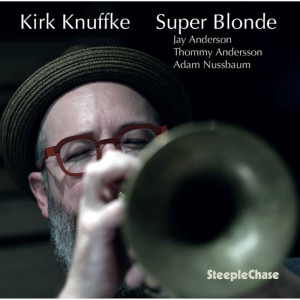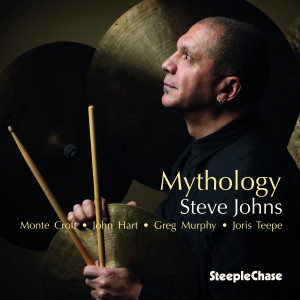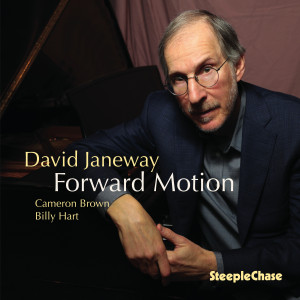 Somehow, this was my first knowing* exposure to the music of Kirk Knuffke, and it has rapidly become one of my current favorite albums. Super Blonde is a consistently engaging set of covers and standards played by a unique quartet consisting of Knuffke on cornet, drummer Adam Nussbaum, and two double bassists, Jay Anderson and Thommy Andersson.
Somehow, this was my first knowing* exposure to the music of Kirk Knuffke, and it has rapidly become one of my current favorite albums. Super Blonde is a consistently engaging set of covers and standards played by a unique quartet consisting of Knuffke on cornet, drummer Adam Nussbaum, and two double bassists, Jay Anderson and Thommy Andersson.
It’s been a busy time, so with this and several other recent releases from Steeplechase that arrived in a tranche
I’ve mostly been listening on headphones at the gym, on walks, or as I do other stuff, just to get a feel for it. It wasn’t long before I noticed those two basses, one in each channel, and thought, “well that’s different.” It’s truly uncommon, especially in an ensemble playing more or less straight ahead but creatively arranged versions of these great standards. Once noticed, it’s hard to miss everywhere. Some examples come in the album’s very opening notes when the two basses play deep thrumming notes together, a brief solo introduction to the sly, bouncy “Willie The Weeper”; and in engaging exchanges on nearly every track, very noticeable on the minimalist arrangement of “Smile,” where first one then the other solos while the other comps; and in the contrapuntal arrangement of “Golden Earrings,” where the two basically play a fugue behind Knuffke’s vinegary soloing.
Drummer Nussbaum very much takes the lead on a swampy rendition of Ellington’s “African Flower,” his percussionistic, painterly swirls very much centered in the mix. But even here the two bassists stand out, with Thommy doing a double-stop arco drone in the left channel and Jay some octave-jumping plucking behind Knuffke’s horn, then both taking up bows for a duet break. The jaunty “No Moon At All” is a standout for me, for Nussbaum’s melodic brushwork, Knuffke’s feathery improv lines, and standout solos from both bassists.
The quartet turns in a bop-style cover of Sun Ra’s “Super Blonde,” a bracing refresher amid some of the more “standard” standards. But there’s no way I can pick a favorite on this album, which is packed with great tunes, great arrangements and great playing.
On his second leader date (his first for Steeplechase) drummer Steve Johns assembles a talented crew that brings to life a set of his and their  compositions, and a couple of standards, in high style. Hip straight ahead jazz, funky blues, softly swinging ballads, some jazzy classic soul, and even a bit of group free improv, Johns and company do it right.
compositions, and a couple of standards, in high style. Hip straight ahead jazz, funky blues, softly swinging ballads, some jazzy classic soul, and even a bit of group free improv, Johns and company do it right.
Though mostly straight jazz, this ensemble paints with a palette of varied colors and textures, particularly from Monte Croft, who mostly plays vibraphone but also cuts loose with some chromatic harmonica and even sings on a couple of tracks; and guitarist John Hart. The rhythm section in addition to Johns on drums is Greg Murphy on piano and Joris Teepe on bass. As with everything else I’ve listened to on this Danish label, the recording is warm yet crisp and clear, with plenty of separation for each instrument; a joy to listen to.
It’s hard to choose standouts, but the bookends, both by Johns, are a good place to start. Opener “Coming Of Age” provides lots of melodic interplay between guitar and vibes, with bass, piano and drums proving a deep and mellow pocket; the title track “Mythology” ends the proceedings in similar manner, a bit more upbeat, just a jaunty, urbane swinging blues.
The quintet digs into some hard bop on “This Is The Thing,” guitarist Hart’s sprightly rearrangement (“contrafact”) of “What Is This Thing Called Love.” Similar in spirit but with an entirely different sound is “Our Time,” bassist Teepe’s contrafact on the standard “Just In Time,” with some nice solo breaks by Johns.
“Mythology” is an album full of imagination, stories and some fantastic playing by this amazing lineup of world-class musicians.
 Pianist David Janeway, a fixture in the NYC jazz scene for many years, turns in a very solid set of standards and originals with his current trio, featuring drummer Billy Hart and bassist Cameron Brown. Upbeat and uptempo are the bywords here, bookended by the solid, tuneful bop of Cedar Walton’s “Martha’s Prize” and a delightful arrangement of Monk’s “Bemsha Swing.” The date consists of seven covers and six Janeway originals, all characterized by the album title Forward Motion.
Pianist David Janeway, a fixture in the NYC jazz scene for many years, turns in a very solid set of standards and originals with his current trio, featuring drummer Billy Hart and bassist Cameron Brown. Upbeat and uptempo are the bywords here, bookended by the solid, tuneful bop of Cedar Walton’s “Martha’s Prize” and a delightful arrangement of Monk’s “Bemsha Swing.” The date consists of seven covers and six Janeway originals, all characterized by the album title Forward Motion.
“The name Forward Motion refers to the most powerful life force, the will and spirit that keeps us moving forward, remaining hopeful, and keeping the faith especially during the darkest of times,” Janeway says in Scott Yanow’s superb liner notes.
That spirit is definitely reflected in the second track “Fully Vaxxed,” a spirited Janeway composition that is a celebration of the days in 2022 when the first Covid vaccines became available and life could resume on some levels after a couple of years of shutdown. Ditto Janeway’s “K’s Shuffle,” a deeply swinging celebration of the pianist’s love for his ebullient wife, on which each member of the trio gets a chance to shine. That spirit really comes to a head on the fierce post-bop “Third World Express,” where drummer Hart really comes to the fore.
There’s plenty of variety, though, including Janeway’s loungey, bossa-tinged “Until The Next Time,” his lush ballad “The Red Thread,” and his cover of the similarly romantic “Star Crossed Lovers” by Billy Strayhorn. Of particular note is the lesser-known Monk composition “Two Timer,” with some particularly strong work by bassist Cameron Brown; and a cooking cover of “Night And Day” where drummer Hart really shines. But really, these three veterans all shine on every track, making Forward Motion a thoroughly enjoyable program of piano trio jazz for all moods.
I’d been thinking a little bit about Chet Baker recently, when I first listened to Alex Norris‘s Table For Three. So I immediately caught where this  trumpeter was coming from, from practically the opening notes of the first track “Tight Grip.” It’s a cool slice of melodic jazz on a simple tune with virtuosic but not flashy solos from Norris and his trio mates, guitarist Paul Bollenback and bassist Paul Gill, which turns out to be just the kind of jazz I’m desperate for on certain days. Table For Three slots in perfectly with the other albums in this omni review — just good solid jazz, played with heart and soul and lots of swing, presented and recorded with clarity.
trumpeter was coming from, from practically the opening notes of the first track “Tight Grip.” It’s a cool slice of melodic jazz on a simple tune with virtuosic but not flashy solos from Norris and his trio mates, guitarist Paul Bollenback and bassist Paul Gill, which turns out to be just the kind of jazz I’m desperate for on certain days. Table For Three slots in perfectly with the other albums in this omni review — just good solid jazz, played with heart and soul and lots of swing, presented and recorded with clarity.
This is a departure for Norris. When he’s not playing with the Mingus Big Band, Spanish Harlem Orchestra and countless other jazz and Latin jazz artists, Norris fronts his own quintet — trumpet, sax, and rhythm section — all more or less known for punchy, in your face and upbeat performance. To paraphrase Neil Tesser’s superb liner notes, this is not that. Trumpet, guitar and bass is a somewhat unusual combo these days, but I like it a lot. Norris’s and Bollenback’s solo turns really stand out; they sound really great in combination in front of the bass, and bassist Gill tosses off his own excellent solos, both plucked and bowed, and in the head sections when all three present the song, it’s a bit of quiet magic. Jazz concentrated to its essence.
The program is mostly Norris originals, eight of them in fact, including that opener “Tight Grip,” the lightly swinging title tune “Table For Three,” on which Bollenback rolls through some unexpected places in his solo, which manages the feat of being quiet and startling at the same time. I really dig the low-key swagger of “Empty Subway Car Blues,” where Gill really sets the tone with his insistent groove.
The three covers each get different treatments, the highly melodic “The Lamp Is Low” as a trio, with one of Norris’s punchiest solos on it; Horace Silver’s hard bop chestnut “Strollin’ ” as a duet with Gill; and the old standard “A Nightingale Sang In Berkeley Square” as a duet with Bollenback and a Harmon mute on Norris’s, horn (think Miles Davis’ sound) one of only two tracks where he uses a mute. The other is the jaunty closing track “Just Wait Till Next Year,” with a cup mute that gives his horn more of a “day at the races” vibe.
Altogether, Table For Three is a highly satisfying album, with a lot more going on than you might expect from this seemingly low-key trio of trumpet, guitar and bass.
(Steeplechase, 2024)
*It turns out that Knuffke is a member of Allison Miller’s Boom Tic Boom ensemble, which I listened to compulsively during the early Covid times.
